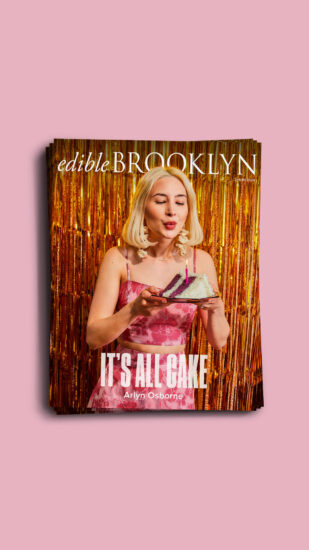
Brooklyn Brewery’s Bel Air Sour unexpectedly cruised into our headquarters this week in bottles, and with a boppin’ packaging design that inspired me to inspect under its hood (i.e. crack one open for a taste) while burbling inanities like “This car was probably used in the filming of ‘Alemerican Graffiti’!” (Also: “Look at the space-age alefins on that one!”)
After a limited draft release earlier this year, Brooklyn Brewery will be offering Bel Air, a dry-hopped sour, in 12-ounce bottles for a short time starting in January. While taking one for a joyride (ugh), I called Garrett Oliver and Andrew Bombard, Brooklyn’s brewmaster and lab manager, respectively.
Edible Brooklyn: Bel Air was first released as a Brewmaster’s Reserve. How would you define that series and the beers released within it, and have those definitions changed over time, especially as you’ve introduced other limited series, the Brooklyn Quarterly Experiment being one?
Garrett Oliver: At one point the Brewmaster’s Reserve series was the only outlet we had for creating new beers that weren’t part of our regular lineup. “BMR” was a big creative engine for us for about 15 years; we brewed all sorts of styles well before they became popular, from witbiers to saisons and all sorts of collaborations. These days we’ve unhinged the series from a set schedule and beers only appear when we think we’ve got something special we want to share. Brooklyn Sorachi Ace started as a BMR and is now a strong part of our lineup. I wouldn’t be surprised to see a similar future for Bel Air. A beer can always hope!
EB: Andrew, Bel Air developed as you worked to isolate the brewery’s house lactobacillus culture. Can you talk a bit about what that process entailed, and also about the work you do as lab manager and how it factors into what Garrett and the brewers are doing?
Andrew Bombard: Definitely. So we wanted a naturally occurring culture that gave us lactic acid without the flavors we didn’t want, those being acetic acid, diacetyl and dimethyl sulfide. This meant that we needed a thermophilic or “heat-loving” lacto as most of these species are also homofermentative, meaning they only produce lactic acid. So we went to the brewhouse and started pulling samples of unfinished mash and sweet wort to begin testing and, after what honestly felt like a year of trial and error, we finally came across one. The fun part for us is that these cultures, a mix of many different types of lactobacillus that all play a role in creating the acidity you find in the finished beer, can’t be purchased commercially! They’re unique to us, to our brewery and to our process and to get a culture like this you have to take your time to let it develop properly, much like a sourdough culture.
Now day to day the lab has many functions in the brewing operations. But from a research and beer development perspective we have a large role and Bel Air is a great example of that. The lab has the ultimate purpose of serving as a resource for the entire brewery. When we can deliver a tangible thing like a new culture for Garrett and the brewers to use you can literally taste the results and the results are delicious. What do you think of it?

EB: It’s really bright and refreshing. I’m a big fan of dry-hopped sours. Garrett, what inspired the beer and started Andrew on his lacto search?
GO: I had wanted to develop a kettle sour, I had a certain type of lactobacillus in mind, and we tried various sources to try and find one. When those didn’t work out, Drew hunted down the right lacto and we were underway. From the first batch, this beer was diverted into a few different side-projects and some of those have come to fruition as well. Drew wanted to dry-hop the first batch, but we had to wait for the second.
AB: The amazing part to me here is just how pineapple-y, lychee and mango-y it is without the addition of any fruit whatsoever. It really speaks to how the addition of lactobacillus and the dry-hopping can lend a fruit kick to something that maybe wouldn’t have otherwise been so.
GO: I call this beer “happy juice.” It’s the culmination of two years of work, but we think it’s been worth the wait.
EB: Andrew, this is named after a Chevy Bel Air you once owned.
AB: Yep. A 1963, white with bright red interior. I was really sad when I sold it before moving to Brooklyn so I’m stoked that its namesake lives on.
EB: Garrett, have you had a car that you loved like that?
GO: A silver 1990 Mercedes 190E, a.k.a. the “Baby Benz.” It was a badass little car, the last Mercedes that still had the old-school look. It was a mini Sherman tank, nobody dared cut me off, ever. Your whole car would be a crumple zone if you crossed bumpers with the 190E.


